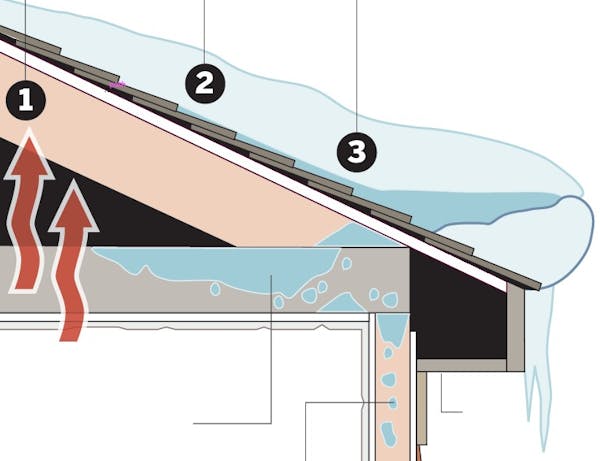On a recent walk around south Minneapolis, Melissa Hansen aimed her camera at what she calls "epic icicles." It didn't take long to find multiple houses fringed with thick daggers of ice, some plunging several feet from their gutters.
This month's below-freezing temperatures and record-breaking snowfall have produced prime conditions for the problem signaled by the frozen spikes: ice dams. If allowed to grow, the ridges of ice can cause water damage inside a home.
"We haven't seen a season this busy in Minnesota in at least five to six years," said Joe Palumbo, owner of Ice Dam Guys, a Minneapolis-based roof ice removal company. "And by the looks of the weather pattern, we'll be on pace to surpass anything we've seen in 10 years."
An ice dam typically forms along a roof's edge or valley, underneath a thick blanket of snow. Poor insulation or venting in an attic space can cause the home's interior heat to escape, melting the snow on the roof. That water then runs down the roof and freezes, forming a dam that grows as the melt-and-freeze cycle continues. Water pooling behind that dam can then leak into the house.
Related
Ice dams and water damage

Snow, which serves as an insulator, only perpetuates the problem. "The greater the snow depth and the fluffier the snow, the worse this problem gets," said Patrick Huelman, a University of Minnesota Extension professor who coordinates the U's Cold Climate Housing Program. "And the warm weather coming is only going to work against us."
When Hansen posted her photos of the magnificent icicles on social media, her friends were quick to comment. One admitted to buying six pairs of pantyhose he planned to stuff with ice melt, hoping a well-aimed toss to the roof might help eradicate an ice dam. Plus, he joked, it would get the neighbors talking.
"I haven't seen any panties out yet," Hansen said. "But I'm keeping my eye out."
The chemical-packed legwear strategy is safer than climbing onto an icy roof and wiser than taking a hatchet to a block of ice frozen to your gutter or shingles, Huelman said. But it's still not ideal.
"It can work, but it'll cause damage below," Huelman said. If there's already a leak into the house, having saltwater seep in will be all the more corrosive. That goes for antifreeze and windshield fluid, too.
And just yanking or hacking away at ice might mean damaging your gutters or shingles.
"At that point, when you already have an ice dam, it's just a risk management problem," Huelman said. "There's just a series of risks there — whether it's safety or damage to the house, damage to the roof, damage to your landscape."
The best thing homeowners can do now — and something they should have already done — is to sweep accumulated snow off the roof.
"At the very least, people need to get serious about raking their roof," Palumbo said. "It should be a Minnesotan's chore. I think people just got a little complacent and stopped doing it."
Overhangs are the most important to keep clear. If you can't safely rake them without climbing a ladder, however, Huelman recommends calling a professional company. But do your research; some less-than-reputable businesspeople are eager to take advantage of panicky customers and may use methods that damage your roof, he said.
Palumbo's company uses steam to break up and remove ice dams, charging $475 an hour with a 3½-hour minimum.
"It's not a cheap service," he said.
Still, by 9 a.m. Thursday, his company's voice mail box was stuffed with more than 200 messages.
"Most people don't call us until their house is already leaking," Palumbo said. "Either that or they had problems in the past and remember what a pain in the butt it was to deal with."
Though it's too late for homeowners already battling a curtain of hanging ice, Huelman and Palumbo both recommend energy audits come spring. Those assessments can reveal areas where heat is escaping the home and can be fixed before another ice dam season arrives.
In the meantime, turning down the thermostat can help slow the melting, Palumbo said.
"And rake your roof," he repeated. "I don't want to be put out of business, but if people just did those things, they wouldn't have to call us."




